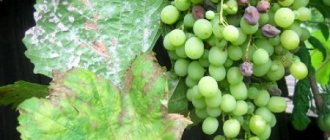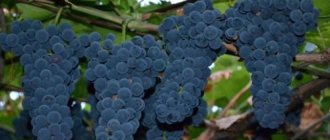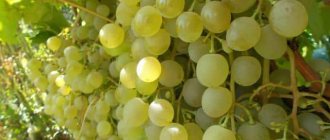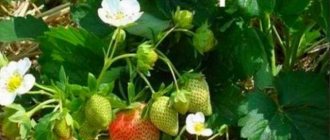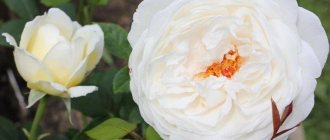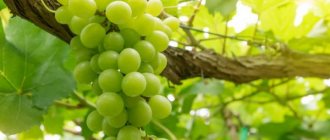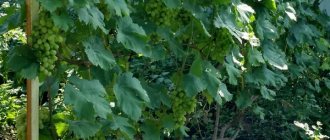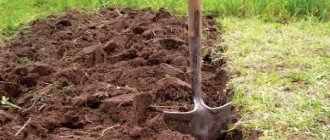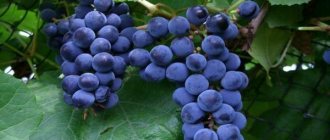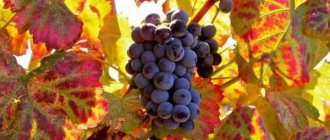Academician grapes: variety description
Academician grapes: photo of variety
Other names of the variety: Akademik Avidzba grapes, Akademik Pamyat Dzheneeva grapes. Breeders crossed the hybrids “Gift to Zaporozhye” and “Richelieu”. This variety - a table variety - is the work of breeders from the Crimean Institute of Viticulture and Winemaking "Magarach". The species was bred not so long ago. Not very popular yet. And also not so widely distributed. Because there is still little material for planting.
You can buy it at the institute. And also in private nurseries. The “Akademik” variety has been listed in the state register since 2014. It is recommended to cultivate it in the North Caucasus. If covered well for the winter, it can also be grown in more northern regions.
Academician grapes: photo of variety
Early ripeness, the first fruits can be seen after 115 days. The sum of active temperature conditions for a shrub to ripen is considered to be 2100 degrees. This suggests that it is possible to plant and grow it in the southern regions. And also in the middle Russian latitudes.
The Academician grape variety has frost resistance identical to that of its ancestors, -23-25 degrees. Thanks to this trait, the variety can endure winter under snow cover in mid-Russian latitudes, if it is well covered.
Shrub of strong growth. Leaves are medium sized. Or large, dissected and five-lobed. The outer part of the leaf plate is smooth. Internal - with slight pubescence. Flowers of both sexes. This means that the variety does not require pollinators.
Pest control and disease prevention
The appearance of diseases and pests is easier to prevent than to treat. Therefore, bushes are sprayed with insecticides and fungicides several times a season. Leaves and other plant debris, which can be carriers of pathogenic microorganisms, should not be left in the root circle.
Note! To prevent the berries from being damaged by wasps, the grape bunches are covered with a net with small cells.
For prevention, grapes are sprayed with insecticides and fungicides several times a season.
Academician Avidzba grapes are suitable for growing by beginning gardeners. Having studied the rules of planting and care and putting their knowledge into practice, winegrowers can easily grow plantings with tasty and healthy berries on their plot. Grapes can be consumed fresh, canned, and surplus sold on the market.
Description of the fruits of the Akademik grapes
Academician grapes: photo of variety
Enlarged clusters of a cylindroconical type contain a large number of fruits. As a rule, the mass of a bunch is 1.5-1.8 kg. The clusters are of average density. May sometimes be loose. The fruit is enlarged, size is usually 33 x 20 mm. The berry is in the form of an oblong oval with a blunt tip.
The berries are dark blue in color and have a noticeable pruin coating. The waxy coating helps protect the fruit from viruses and bacteria that carry diseases. And also the pruin coating helps to cope with weather changes. Fruits with a pruin coating are much better to transport and store than fruits without a coating. The peel is durable. Which is also a big plus when transporting fruits.
Akademik table grape variety. Because the taste and commercial qualities of the fruit are at a high level. Tasting assessment of the taste of the berry is 9.8 points out of 10 possible. The fruit has a nutmeg flavor. The presence of cherry flavor is felt. And also the aftertaste of chocolate is added to this. Increased sugar level.
Currently, Akademik grapes are on a probationary period. But you can already understand that it will definitely be cultivated on large plantations. And of course, the variety will be popular among amateur winegrowers. They will cultivate it on their territories. Because many people have already heard about the quality of the fruits. And everyone wants to find out in practice what kind of variety it is. The Academician grape variety has average immunity to common diseases: mildew and oidium. Therefore, prevention is necessary.
Description and characteristics
Sheet.
Inflorescence.
Crown.
The hybrid turned out to be very interesting, it belongs to the dessert type.
- The berry is incredibly large with a violet-blue tint . It takes on an elongated oval shape and has a matte, light-colored coating.
- The shell is thin and dense , but this does not in any way affect the taste when eaten.
- The pulp is dense and crispy , has a very rich and aromatic nutmeg taste with a cherry and chocolate aftertaste.
- The bunch ripens perfectly, completely covered with fruits and has an average weight 600–900 grams. There are cases when, with good climate and care, the bunch reaches 1500–1700 grams. It has the correct conical shape, which gives an aesthetic appearance.
Berry.
Bunch.
The variety is an early variety and ripens within 115 days . The bush is tall, which allows it to be planted to decorate gazebos or arches. The leaves have a carved large shape with variegated triangular ends. The upper side is glossy with a noticeable shine, the lower side has a barely noticeable fluff. Due to the fact that the variety was recently bred, all qualities have not been fully studied and are being tested.
Academician grapes: planting rules
The Academician grape variety is recommended for cultivation in the subtropics. And also in a temperate climate zone. In other areas, adaptation and yield indicators are completely dependent on the knowledge and skills of the person who decides to grow the variety on his plot. The most important rule when planting is to follow proper agricultural techniques.
How to choose a site for planting
In the southern regions, the Akademik grape variety is grown under elevated temperature conditions. At times above +40 degrees. The optimal temperature conditions for planting and growing the Akademik grape variety are 28-30 degrees. In such conditions, it is simply necessary to provide shading for the plant. For the northern regions, on the contrary, it is necessary to find a place where sunlight is constantly directed at the bush. Another important rule is that the grapes must be protected from the winds.
Tips from experienced gardeners : plant vines from the south of buildings. To the north of the grapes, tall trees need to be planted. Or make hedges. And also build a fence or make screens. This is all necessary so that the temperature conditions of the air and soil are higher. That is why you can get a good harvest.
Advantages and disadvantages of the variety
Academician Avidzba attracted the attention of many gardeners due to his unique qualities:
- early harvest ripening;
- exquisite taste;
- large size of berries and clusters;
- good transportability;
- high yield.
However, quite often the variety is affected by various diseases. When grown in the middle zone, it needs shelter.
Sum of active temperatures - what is it?
Grape variety Academician: photo
To achieve the required level of sugar content, for complete ripening of fruits, the sum of active temperatures (SAT) is needed. The grapevine begins the growing season at soil temperature conditions of at least +10 degrees. Active temperature conditions for air are more than +10 degrees. If you add up all the numbers of average daily temperature conditions, starting from the start of the growing season and ending with the ripening of fruits completely, you will get the sum of active temperatures. It is individual for each grape variety. For the Akademik SAT grape variety, 2100 degrees is considered. This is an average figure at Moscow latitude. Summer is not always warm. Therefore, in some summer seasons the grapes may not fully open.
To increase the amount of active temperatures, gardeners use various tricks. Plants are planted on the south or southwest side of buildings. To keep warm. Provide protection from northern winds. Cover the soil around the bush with darkening agents. Whether it's manure or black spunbond. Dark colored stones can be used. Reflective screens are also used. They are made from foil or white polyethylene film. Someone plants grapevines in greenhouses.
Two sides of the coin
Of course, the variety turned out to be a success and, due to its relative unpretentiousness, is convenient for growing not only in sunny areas. However, some nuances and difficulties when growing this species are still present. Which ones exactly? Weather sensitivity: berries do not tolerate moisture and precipitation well, so they require shelter in winter. They also require careful care during the off-season.
There is susceptibility to bird and wasp raids, as well as a predisposition to fungal diseases and plaques. PD requires preventive measures to protect against powdery mildew. Actually, this variety does not require more care than others. Exactly how to care for it and how to more reliably protect the berries from pests and pecks is described below.
Academician grapes: planting
The existence of Academician grapes in comfortable conditions is completely dependent on how you plant it. Grapes can be planted in spring and autumn. It is recommended to choose a bush in a container for this. In this case, it will 100% take root, if, of course, you plant it correctly. If the soil type is sandy and the winters have little snow, we plant grapes in trenches. If the soil type is clay, then beds are suitable for planting.
Work progress
- Dig a planting hole. The diameter should be similar to the diameter of the plant's root system. We remove the top of the soil to the side - this is a fertile layer. Now it is necessary to mix this fertile layer with humus and a mineral complex. Make a drainage system from gravel and small branches at the bottom of the recess.
- Secure the pipe, which is intended for applying liquid fertilizers. Place the plant in the hole. Pour in the same fertile mixture. And water it. Trim the shoots, leaving 2 buds. To prevent the cut area from drying out, it must be treated with paraffin, having previously melted it. Mulch the hole with humus or compost fertilizer.
- The interval between bushes should be within 1.5 meters or more. Because each bush must have an optimal area for growth and development. If you are planting a large plantation, adjust the row orientation from south to north. This way there will be more sunlight.
Grapes Academician: agrotechnical techniques
Academician grapes: photo of variety
The Academician grape variety is a table grape variety; for this reason, watering must be carried out consistently. The first watering is carried out after the bushes have fully opened. And the vine is tied to trellises. An adult bush requires 4 buckets of warm water. You also need to add 0.5 liters of wood ash. It will be very good if, when planting, you put a pipe near the bush for watering and fertilizers. In this case, all the water will flow exactly to the roots.
- The second watering is carried out 7 days before the grapes begin to bloom. When the vine blooms, watering is prohibited. Because flowers may fall off. The fruits will not grow to the required size. Therefore, the berries will be the size of peas.
- The next watering is carried out after the plant has flowered. Watering is prohibited when fruit coloring begins. Because the berries will not accumulate sugars. Extreme watering is carried out 7 days before the end of sheltering plants for wintering.
How to plant correctly
For timely development and stable fruiting, Academician grapes require:
- timely and balanced watering;
- loosening the soil in the root zone and removing weeds;
- applying fertilizers according to needs;
- preventive treatment against diseases and pest invasions;
- health pruning and thinning of the thickened crown.
High-quality care and timely implementation of all the above operations helps to form a healthy plant and receive a stable harvest every year.
Recommendations for choosing deadlines
There are no exact recommendations for choosing the timing of planting Academician grapes. There is ongoing debate among gardeners about the advantages and disadvantages of spring and autumn planting. There are many pros and cons to one option or another.
In spring, planting occurs at the end of March or April, when the buds begin to bloom and the soil warms up to +8 °C. In autumn, grapes are planted after the leaves have fallen. Don't delay planting and wait for frost. The most suitable period for this exciting event is September-October, when the air temperature ranges from +5 °C to +15 °C.
Site selection and preparation
For uniform ripening of berries, Academician Avidzba needs the sun. The southern and southwestern sides of the site contribute to uniform illumination of the bushes and ripening of the berries.
When planting grapes in lowlands, there is a high probability of the root system freezing in winter in regions with low temperatures.
How to select and prepare planting material
When choosing a seedling, winegrowers recommend adhering to the following rules:
- purchase seedlings from trusted suppliers and avoid buying in markets;
- choose a seedling with a moist root system at least 20 cm long, tightly packed in plastic film;
- the root cut should have a milky or light brown color, when squeezed it releases moisture;
- a clean trunk confirms a strong plant.
A healthy seedling guarantees high survival rate and allows you to grow a highly productive plant.
Planting scheme
Free placement of seedlings contributes to the fruitful cultivation of grapes. Leave at least two meters between plants, and about four meters between rows. Thanks to this placement, the vigorous Academician Avidzba will receive enough sun and be well ventilated.
Grapes Academician: feeding
The Academician grape variety likes root feeding and spraying. The first feeding is carried out after the winter shelter has been removed. Solution for one plant: superphosphate (20 g), ammonium nitrate (10 g), potassium salt (5 g). Mix the ingredients in 10 liters of water. The second feeding is 14 days before the plants begin to bloom. The third feeding is before fruit ripening. Superphosphate and potassium salt are added. After harvesting, you need to feed the plants with a potassium mixture. Because this way the bush will be more resistant to winter.
Fertilizing applied in the spring can be replaced with organic matter. Add 1 part slurry to 10 parts water. Each plant requires 1 liter of fertilizer. Every 3 seasons in the fall, manure is applied to the shrubs. It is also necessary to immediately add ash, superphosphate, and ammonium sulfate. Feed with dry fertilizers while digging up the soil. If the soil is sandy loam, you need to dig often. If the soil is sandy, then digging is carried out annually.
Spraying with a complex of minerals is carried out before the grapes bloom. The second spraying is done after flowering. Third, when the fruits ripen. The two extreme feedings should not contain nitrogen-containing fertilizers.
Pruning procedure for Akademik grapes
If there is no frost, you can form a bush on a high trunk. In the north, the bush is formed without a trunk. Pruning is done in the fall. In spring, it is allowed to prune the bushes before the sap begins to flow. If you prune plants while sap is actively moving, wounds will remain. The bush will die.
In spring it is necessary to prune weak shoots. Make the formation of the sleeve standard. Fruitful branches will then grow on it. In the first month of summer, the formation of the bush usually ends. You need to leave 5 leaves above each brush. And also pinch the top of the shoot. Regulating the overload of the bush - you need to leave 1-2 tassels on the shoot. The fruits are currently growing to the size of a pea. It is necessary to remove excess tassels.
Leave 13-15 leaves on each branch and pinch the top. Throughout the summer season, excess shoots are trimmed. 20 days before harvesting the fruits, you need to thin out the bushes. Trim off leaves at the bottom that interfere with the ripening of the grapes.
In autumn, the bush is pruned after the leaves have fallen. At temperatures closer to 0 degrees. As a rule, all shoots that have not matured are pruned. And also weak shoots. All leaves that have not flown around are removed.
Preparing Akademik grapes for winter
The Akademik grape variety is moderately resistant to frost. For this reason, the bush must be covered. The vines are removed from the trellis. Then they are tied and sprinkled with soil or peat. You can also make such a shelter: wrap the bundles in 2-3 layers of spunbond. Then install low arms. And cover them with film material. You need to make small cracks in it for air.
Reproduction
You can grow Pamyat Dzheneev grapes on the plot using cuttings, layering, or grafting. The latter method is used by experienced winegrowers. The propagation procedure by grafting is usually carried out in the spring, when 2-3 leaves appear on the vine. At the same time, cuttings are planted, cut in the fall and stored in the basement in winter.
One of the ways to propagate grapes is layering.
For beginning gardeners, it is recommended to propagate grapes by layering, which is done in early summer as follows:
- Dig longitudinal furrows about 10 cm deep.
- Layers are placed in them.
- Water and cover with soil.
Until late autumn, the cuttings are watered and the weeds growing around are removed. When young plants appear, they are separated from the shoot and transplanted to the site.
